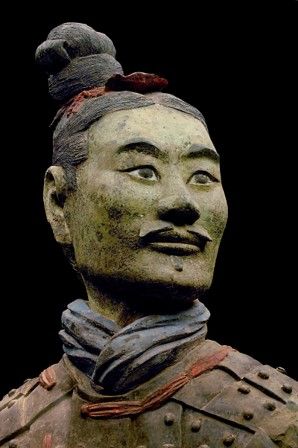Horse Power: €10 million for project in which Terracotta warriors meet the ancient Mongolian state
Monday 24th Oct 2022, 3.02pm
It is one of just 29 Synergy grants being awarded by the European Research Council today, from 360 applications. A total of €295 million is being awarded.
Two major states: the Xiongnu in Mongolia and the Qin in China dominated the region from the European steppe to the plains of China. The Xiongnu arose in 209 BCE and set the model for mobile horse-borne states through to the rise of the Mongols 1400 years later. The Qin took over China in 221 BCE, providing the model for the bureaucratic Chinese state down to today. Both developed through local historical forces, but also in interaction with each other, an interaction which set the basis for the Silk Road.
 Terracotta warrior from the first emperor Qinshihuang mausoleum, China
Terracotta warrior from the first emperor Qinshihuang mausoleum, ChinaProfessor Gosden says, ‘The ancient Chinese state created some of the world’s most impressive monuments, one of the foremost of which is the First Emperor’s Mausoleum with its terracotta warriors. The horse-borne states of the steppe laid the basis for the Silk Road which connected up the whole of Eurasia. The Horse Power project will use the latest scientific techniques together with critical thought from the social sciences to understand the interaction of China and the steppe through the trade of horses for metals. We look forward to working closely with colleagues from China, Mongolia and across Europe.’
The ancient Chinese state created some of the world’s most impressive monuments, one of the foremost of which is the First Emperor’s Mausoleum with its terracotta warriors. The horse-borne states of the steppe laid the basis for the Silk Road which connected up the whole of Eurasia
Professor Chris Gosden
The core hypothesis of Horse Power is that horses moved south into China from the Steppe, while Chinese metals went north. Both the states of the Xiongnu and Qin carefully organised human power, but human power ultimately rested on the legitimacy provided by spiritual forces, what the Chinese call the Mandate of Heaven.
The early burial complexes known as khirigsuurs contained a central human burial, surrounded by up to thousand satellite mounds, each of which contained a single horse, usually just the head and hooves. In China the famous terracotta warriors were not a model army, but an army of the dead to protect the First Emperor from attack and the emperor was also provided with a full administration, stables, wives, entertainers and musicians. To be dead for the Qin was to exist and act in another realm, with the actions of the dead helping to ensure the well-being of the living.
I am particularly excited about sequencing DNA from the horses that contributed to build the first steppe empire in history and the first Chinese Imperial dynasty
Ludovic Orlando
Director Ludovic Orlando, of the Centre for Anthropobiology and Genomics of Toulouse at the French CNRS, adds ‘I am particularly excited about sequencing DNA from the horses that contributed to build the first steppe empire in history and the first Chinese Imperial dynasty. This will not just reveal those biological traits that were essential to form large herds and to rise cavalries but also the origins and the main streams of animal exchange across the region.’
Ruiliang Liu, of the British Museum, adds, ‘Horse Power will contribute a range of vital scientific data to transform our understanding of how large-scale organisation such as a state gradually emerged in different geographical contexts in human history, particularly the rise of Xiongnu in the northern steppe and Qin in the southern plains.’
Horse Power will contribute a range of vital scientific data to transform our understanding of how large-scale organisation such as a state gradually emerged
Ruiliang Liu
As part of the six-year project, the team will excavate both khirigsuurs and the First Emperor’s mausoleum complex. The study will cross linguistic boundaries (Chinese, Mongolian, English) in a spirit of the co-production and will be cross-disciplinary, taking in techniques from science and social science.
Ursula Brosseder, of Bonn University, says, ‘Together with our partners, the National University of Mongolia and the First Emperor’s Mausoleum Museum, we will work towards capacity building and are excited to work across cultural and linguistic boundaries (Chinese, Mongolian, English) in a spirit of co-production.’
Together with our partners, the National University of Mongolia and the First Emperor’s Mausoleum Museum, we are… excited to work across cultural and linguistic boundaries
Ursula Brosseder
Horse Power will also include an innovative programme of public engagement and outreach, involving communities outside academia in photography, art and discussion through blogs and websites, particularly aiming to show that big historical and cultural questions can only be tackled in synergistic ways, by a team with varied cultural and intellectual backgrounds. It will include also exhibitions in Mongolian, Chinese and British museums.
Almost 360 proposals were submitted in this first ERC Synergy Grant call under the EU’s Horizon Europe programme. The funding, worth in total €295 million, went to 29 winning projects involving 105 principal investigators who will carry out their research at universities and research centres in 19 countries across Europe and beyond. Sixteen principal investigators will be based USA, Australia, UK or Switzerland.
For more information follow this link: https://www.arch.ox.ac.uk/article/horse-power-eu10-million-erc-synergy-grant-project-which-terracotta-warriors-meet-ancient

